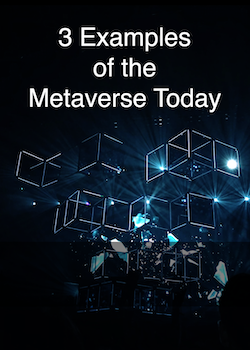 The concept of a fully immersive metaverse has been around for some time now. Do you remember the game Second Life, from 2003? That was an extremely basic, early version of the concept. An immersive, openly shared virtual space.
The concept of a fully immersive metaverse has been around for some time now. Do you remember the game Second Life, from 2003? That was an extremely basic, early version of the concept. An immersive, openly shared virtual space.
However, where the actual metaverse will differ lies in the advanced Virtual Reality technology it will incorporate. Mark Zuckerberg has described the concept as “the internet you’re inside of, rather than just looking at”.
3 Metaverse Examples
Ready Player One
If you’ve read this book, or seen the movie, you’ve already got a pretty decent idea of what the metaverse is trying to be.
This science fiction story tells the tale of people seeking escape from a miserable dystopian world, into an MMORPG, a massively multiplayer online role-playing game. This game, called OASIS, serves as a virtual world of escape, with its own culture, society, and even currency.
IMVU
While this game was never quite as popular as something like Second Life, it has amassed quite a user base over the years.
This is an avatar-based 3D social network. You can hang out with your friends in various areas, go to gatherings and events, and even use and earn real-life money with virtual products.
IMVU boasts a 7+ million userbase, most of which spend an average time upwards of 55 minutes on the website.
Facebook’s Horizon Worlds
Since Facebook, and specifically Mark Zuckerberg, is spearheading the metaverse movement, it makes sense that they’ll have a prototype of some kind. Facebook’s Horizon is a project currently in beta, that claims to be an expanded Virtual Reality world.
Facebook has described Horizon as “a social experience where you can explore, play, and create with others in VR. It’ll make good use of those Oculus headsets.
In Conclusion
The metaverse is going to take a lot of manpower and hours to get up and running. There won’t be a sudden moment where a switch is flicked somewhere and suddenly the metaverse is up and running. It will more likely be a “slow and steady upgrades” type of situation, whereas technology advances and greater innovation comes along, the metaverse itself will upgrade along with it.
Once it really gets going, the metaverse will be life-changing for quite a large number of people, both businesses and consumers. While this has yet to fruition, the potential applications for the metaverse are enormous.
This wraps up my series on the metaverse. I hope that this high level look has given you more knowledge on what it is, where it may be going and when it may happen.
For more information, you may want to check out the following articles:
https://www.realtrends.com/articles/the-metaverse-is-the-new-frontier-of-real-estate/
If you missed one of the series, just go to https://realtytechbytes.com/category/metaverse/ to see all 6 of the current series, please two previous posts on the metaverse.
Discover more from RealtyTechBytes.com by Jerry Kidd
Subscribe to get the latest posts sent to your email.







